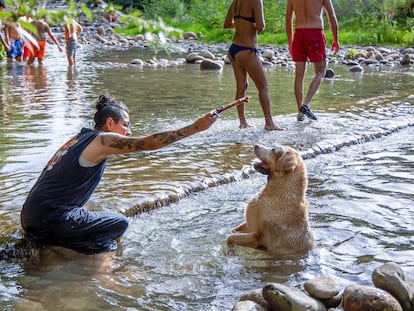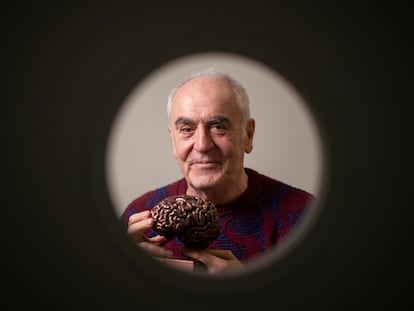Science vindicates dogs as sentinels of human health
Researchers point to the need to establish a program among vets that might flag up epidemics among humans

For centuries, workers went down coal mines accompanied by a canary in a cage. Being small, this animal suffered the effects of toxic gases before humans and could serve as an alarm in the event of a gas leak. More than a canary, it was a sentinel — an indicator of danger. A similar approach is proposed in an editorial published in the journal Science, which suggests that the health of our dogs could flag up health problems for humans. As they share space with their owners, dogs can help us to study the epidemiology of vector-borne pathogens or the effects of exposure to heavy metals or microplastics, and even the effects of social hardship, according to the authors of the report.
“Dogs are special animals because they have coexisted with humans for about 30,000 years. By sharing space, the factors that can influence their health are very similar to ours,” explains Courtney L. Sexton, a professor at the University of Virginia and co-author of the paper with Audrey Ruple. The way dogs move around the world also means they experience a higher incidence of infectious diseases. They absorb everything they are exposed to, spend more time in areas populated by disease vectors, such as countryside inhabited by ticks, and have no hygienic habits. Finally, they live much shorter lives than humans, so “we are often able to make connections between environmental impact and life outcomes more quickly in them,” Sexton explains.
There have already been some isolated examples of sentinel dogs. In 2007 in the United States, an increase in kidney failure in pets led to the investigation and subsequent recall of a contaminated dog feed. This feed was also used for chickens and pigs intended for human consumption and was quickly recalled, avoiding possible consequences in the local population. According to the authors, the idea would be to turn this case — currently an exception — into something more like a rule. And this would require improving canine data collection, with a sentinel program in veterinary clinics. “This would help assess the health of people who cohabit with dogs,” the researchers state in their report.
The context is favorable because of the way our relationship with pets has evolved. “On the one hand, veterinary medicine has greatly improved; there are more analytical techniques,” says Guadalupe Miró, Professor of Parasitology and Parasitic Diseases at the Complutense University of Madrid. Animals today are far better controlled than a few years ago and it would be easier to detect outbreaks of certain diseases.
“On the other hand, there has been a lot of relaxation regarding direct contact habits,” adds Miró. “Dogs used to be working animals and people had less contact with them. Now it is considered fun to have a dog lick your face and many people share their beds with them. You have to understand that you have to take care of their hygiene.” This relatively new approach to pet ownership makes it easier for diseases to pass from one species to another. Dogs and people do not share many diseases, but they do share vectors such as ticks, as well as certain infections and, also, a number of diseases originating from parasites, such as leishmaniasis.
Dogs or cats?
The Science report emphasizes the concept of One Health. “It’s a transdisciplinary approach to public health that is based on the principle that the health of people, the environment and the other animals with whom we share the environment are interconnected,” explains Sexton, who says that while the underlying concepts are not new, there has been renewed recognition of this idea in the last 20 to 30 years.
Miró exemplifies this idea of One Health by referring to a case she personally worked on: the Fuenlabrada outbreak. “It was an outbreak of leishmaniasis that emerged in the Madrid region in 2010. Suddenly, there was a boom of cases in nearby hospitals in the south of Madrid,” she says. At first, they thought the disease could have passed from dogs to people, but when they sampled dogs in the area, they realized this was not the case. Then the experts turned their attention to a newly created park. “In the Polvoranca park, there was a huge population of hares, due to the lack of predators. And they realized that the vectors fed on the hares, actively multiplied and began to infect people who went to the park for a walk.” This flagged up how closely related human health is to that of the animals with which they live and the environment in which they move.
In an editorial response also published in Science, Ramiro Pastorinho, a researcher in the Department of Medical and Health Sciences at the University of Évora, Portugal, says that the present study highlights the not-so-obvious role that companion animals can play as sentinels of public health, social welfare and human health. Pastorinho praises the study’s vision but qualifies some of its ideas. “The belief that, among companion animals, dogs are the best positioned to perform the task of sentinels of toxic exposure is debatable,” he says. “For instance, cats, due to their grooming habits (resembling children’s hand-to-mouth behaviors), are much better sentinels of exposure for toddlers.”
Both dogs and cats can act as sentinels of our health. They have the same advantages and the same limitations. However, the veterinary network has neither a sentinel program nor a centralized system. It is difficult to pool isolated cases and detect a trend. It is difficult to understand pet health in a global way. But as the Science report states, it is important to change our mentality; collecting data more efficiently can not only improve the health of pets, but do the same for their owners.
Sign up for our weekly newsletter to get more English-language news coverage from EL PAÍS USA Edition
Tu suscripción se está usando en otro dispositivo
¿Quieres añadir otro usuario a tu suscripción?
Si continúas leyendo en este dispositivo, no se podrá leer en el otro.
FlechaTu suscripción se está usando en otro dispositivo y solo puedes acceder a EL PAÍS desde un dispositivo a la vez.
Si quieres compartir tu cuenta, cambia tu suscripción a la modalidad Premium, así podrás añadir otro usuario. Cada uno accederá con su propia cuenta de email, lo que os permitirá personalizar vuestra experiencia en EL PAÍS.
¿Tienes una suscripción de empresa? Accede aquí para contratar más cuentas.
En el caso de no saber quién está usando tu cuenta, te recomendamos cambiar tu contraseña aquí.
Si decides continuar compartiendo tu cuenta, este mensaje se mostrará en tu dispositivo y en el de la otra persona que está usando tu cuenta de forma indefinida, afectando a tu experiencia de lectura. Puedes consultar aquí los términos y condiciones de la suscripción digital.
More information
Archived In
Últimas noticias
The operation in Venezuela to capture Maduro threatens to widen the cracks in the MAGA movement
Trump clarifies who is ultimately in charge in Venezuela: ‘Me’
Maduro pleads not guilty before the federal court in New York: ‘I am still the president of Venezuela’
A new test can detect Alzheimer’s from a finger prick
Most viewed
- Gilles Lipovetsky: ‘If you want to live better and fall in love, take Prozac, don’t look to philosophy’
- Alain Aspect, Nobel laureate in physics: ‘Einstein was so smart that he would have had to recognize quantum entanglement’
- Alvin Hellerstein, a 92-year-old judge appointed by Bill Clinton, to preside over Maduro’s trial in New York
- Why oil has been at the center of Venezuela-US conflicts for decades
- Cuba confirms death of 32 of its citizens in the US attack against Venezuela











































